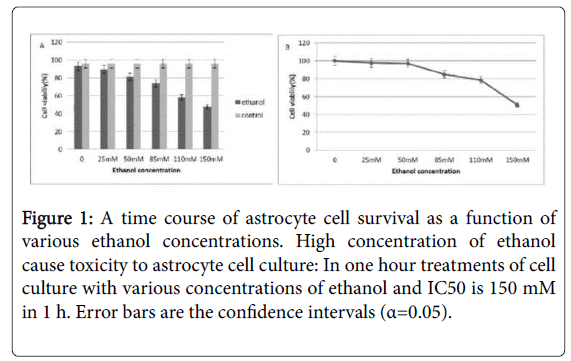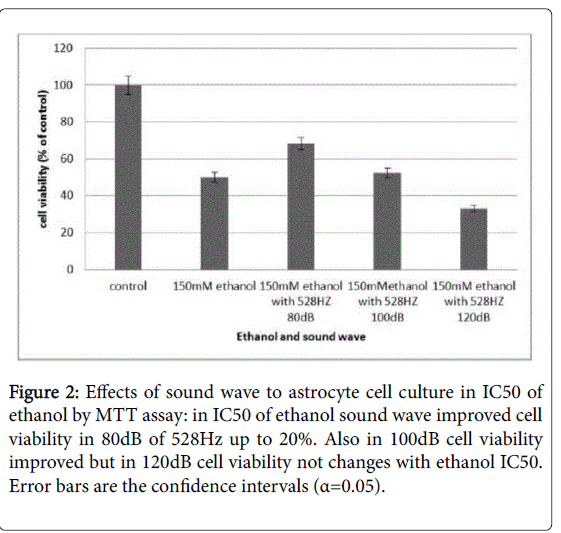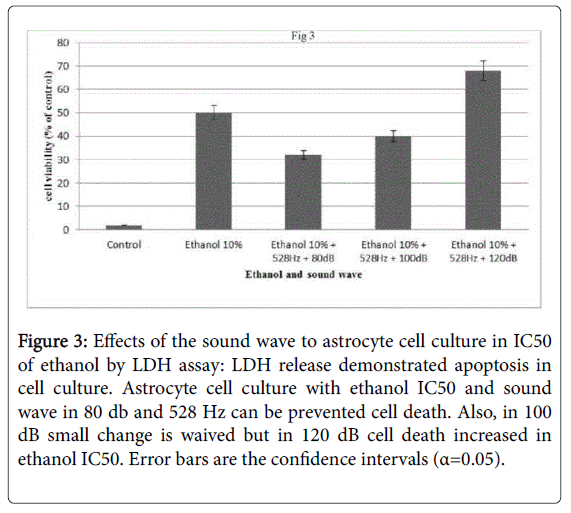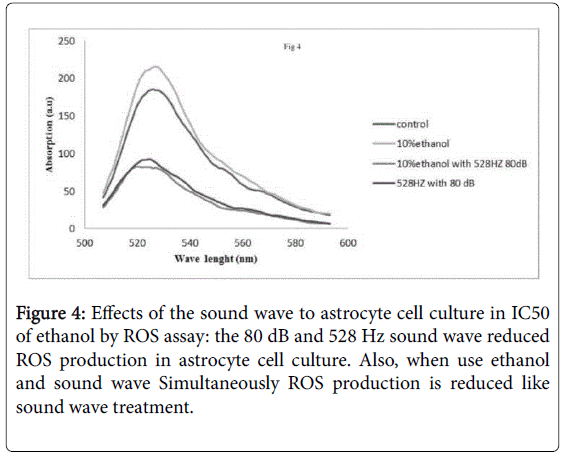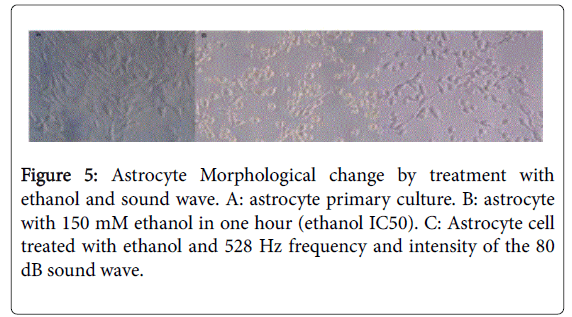Research Article Open Access
The Effects of 528 Hz Sound Wave to Reduce Cell Death in Human Astrocyte Primary Cell Culture Treated with Ethanol
Tohid Babayi and Gholam Hossein Riazi*Department of Biochemistry, Institute of Biochemistry and Biophysics, University of Tehran, Tehran, Iran
- *Corresponding Author:
- Gholam Hossein Riazi
Head of Biochemistry Department
Institute of Biochemistry and Biophysics-University of Tehran
Tehran, Iran
Tel: +98 21 61112473
E-mail: ghossein.riazi@gmail.com
Received date: June 20, 2017; Accepted date: July 05, 2017; Published date: July 12, 2017
Citation: Babayi T, Riazi GH (2017) The Effects of 528 Hz Sound Wave to Reduce Cell Death in Human Astrocyte Primary Cell Culture Treated with Ethanol. J Addict Res Ther 8:335. doi:10.4172/2155-6105.1000335
Copyright: © 2017 Babayi T, et al. This is an open-access article distributed under the terms of the Creative Commons Attribution License, which permits unrestricted use, distribution, and reproduction in any medium, provided the original author and source are credited.
Visit for more related articles at Journal of Addiction Research & Therapy
Abstract
Objective: Alcohol consumption, because of damaging effects on various tissues including nerves system, causes a major problem in human societies. Nowadays, Usages of the non-pharmacological and non-invasive agents is common. Sound waves which are classified in non-invasive agent, beside on stimulation the auditory cells, also impact on non- auditory cells. It has been reported that the frequency of 528 HZ is related to the note MI and it shown some strange effects such as increasing the ability of DNA repair.
Materials and methods: In this paper, with MTT, LDH and ROS assays, it was evaluated the effect of ethanol on astrocytes primary cell culture which exposed to this frequency.
Results: The current results show that in IC50 of ethanol, the frequency of 528 Hz increased cells viability about 20% and the level of ROS production has been reduced up to 100%.
Conclusion: Therefore, the use of these sound waves can be useful to reduce the toxic effects of ethanol on astrocytes cells culture.
Keywords
Nerves system; 528 Hz Sound wave; Astrocyte; ROS production; Ethanol
Introduction
Alcohol addiction is a chronic recurring disorder that it characterized by repetitive patterns of alcohol consumption leading to a loss of control due to alcohol intake [1,2]. Experimental studies have shown the structural and functional changes in neurons and astrocytes with chronic alcohol consumption [3,4]. Some changes, such as cognitive function and fine gross-motor performance are also observed in children by the fetal alcohol syndrome [5]. Ethanol alters the physical structure of the cell membrane and particularly effects on membranes with low cholesterol. On the other hand ethanol increases saturated fatty acids and cholesterol in membrane, which would reduce ethanol effect [6]. Alcohol abuse causes disorder in synaptic plasticity and neuronal function related to synaptic plasticity [7]. The neural changes induced by alcohol consumption may be related to the disorder of signaling pathways such as protein expression and gene transcription at the cellular level [8,9].
The central nervous system (CNS) consisting of neurons and glial cells, is the main targets of ethanol toxicity. Most of glial cells are astrocytes which are tenfold more than neuron’s population in CNS. Astrocytes play an important role for normal growth and neural function. Glia cells contiguously cover whole CNS and exert many essential complex functions [10]. Several neurotoxins can be showing various effects in astrocyte cells [11]. Many researches confirmed that chronic ethanol consumption seriously impairs the astrocyte cells growth [12,13]. Due to important role of astrocyte cells in normal CNS function, the effect of external agents in astrocyte cells affects in brain function. Mechanical factors including sound wave and electromagnetic wave as important external agents with different source can be effect on biological systems. The biological effects of electromagnetic waves have been extensively studied. On the other hand, we are frequently exposed with different sound waves with various biological effects. Furthermore, evaluation of these effects plays an essential role in better understanding of biological changes. Recent studies indicated that beside of auditory cells, another cells also able to respond to audible sound waves. On the other hand, the pressure feeling and vibration associated with sound waves, cause by the impact of the waves on the chest and throat cells [14,15]. One research in human gingival fibroblasts culture showed that the frequency of 261 Hz could alter cell growth and also observed that sound wave stimulation could cause dramatic changes in protein structure of tobacco cells including increasing alpha-helix and decreasing β-turn. Effects of Sound waves at 1 kHz and 100 dB for 1 h within a distance of 20 cm could dramatically increase the cell wall fluidity, division of callus cells, and the power of endogenous hormones and also enhance the protective enzymes activity. Sound waves stimulation could enhance the activity of ATPase in plant plasma membrane, the amount of soluble proteins, sugars and activity of amylase in callus. The sound waves could also increase the amounts of RNA and transcription in planet cells in which induced genes by different types of sound stress could produce more effective productions [16]. 528 Hz which known as the ‘Miracle’ tone, is a sound wave that it can cause significant and extraordinary changes in biological functions. It has been documented that frequency of 528 Hz activated DNA repair. At 528 Hz frequency the water molecules surround around DNA and support its six-sided hexagon DNA structure [17]. According to these important effects of 528 Hz frequency, we suggested that this sound wave will have a key role in function of CNS. In this research the complex effects of two agents such as ethanol along with 528 Hz sound wave was studied and results of human astrocyte cell culture exposed with ethanol and 528 Hz sound wave showed that the ethanol damages reduced by the sound wave and therefore it can be useful for alcohol addicted peoples.
Materials and Methods
Primary cell cultures
Fetal human astrocytes obtained from BONYAKHTEH Lab in Tehran. All cells were cultured in 160 mL sterile flask with DMEM medium and 10% Fetal Bovine Serum (FBS). The medium was changed every two days and stayed in culture for 11 days to reach confocal shape. Then medium was removed and 1 ml trypsin-EDTA solution was added to each flask for 5 min at 37°C and 5% CO flow. To inactivating of trypsin used addition of 1 ml FBS/flask completed with penicillin/streptomycin and 150 mM FBS. The cells were centrifuged at 300x g for 4 min. Then cells were counted by using a hemocytometer. Next, the cells rinsed with sterile phosphate buffer to remove trypsin.
Treatment of cell culture with ethanol and sound wave
Cell culture treatments with 25 mM, 50 mM, 85 mM, 110 mM, 150 mM, 250 mM and 500 mM Ethanol and cells were exposed to the 528 Hz sound wave produced by four speakers (Adam AX8), surrounding cell culture in same distance, which were suspended by a little platform, and not to contact with floor. As controls, the cells were exposed to silence (any speakers in the incubator) and to the speakers plugged to the computer without any sound production, to observe a possible action of the background noise or the magnetic field produced by the speakers. The sound wave frequency produced by Matlab software (sound producer device is composed four speakers linked to Matlab software of computer).
Cell viability
The number of viable cells was determined using standard trypan blue exclusion.
Cells were washed twice with PBS and then re-suspended with EDTA and then stained with 0.5% trypan blue, and the number of viable cells was counted by hemacytometer. The results of counting demonstrated as percentage viability (number of viable cells/number of total cells per well × 100) for each concentration of ethanol and sound wave density. Cell viability was also assessed using the MTT assay. Metabolic activity of cells incubated in the presence of different concentrations of ethanol and sound wave were evaluated by MTT assay. To MTT stoke preparing; 5 mg of this compound was dissolved in 1 mL of phosphate buffered saline. After incubation, 50 ml of the supernatant medium is removed to measure lactate dehydrogenase activity and then 5 mL of stock MTT was added to each well. After four hours storage at 37°C, Reaction was stopped by adding 100 mL DMSO or 0.04 normal HCl in isopropanol solution. This solution makes the dissolved purple precipitate formazan chromophore in cells and then was measured by ELISA plate reader at a wavelength of 570 nm. The results were defined and expressed as a percentage of the control viability.
Determination of ROS
ROS Production in cell culture was detected using a dichlorodihydrofluorescein diacetate (DCDHF) fluorescent probe obtained from Sigma Aldrich. This compound is an uncharged cell permeable molecule. In cells cytoplasm, this probe is cleaved by nonspecific esterase and converted to forming carboxydichlorofluoroscein, which is oxidized in the presence of ROS. Cells cultures were loaded with 10 M in DCDHF serum free medium for 30 min at 37°C. Next, cells were washed and incubated in medium and were treated as indicated in the figure legends. Fluorescence spectroscopy was monitored by microplate fluorimeter, respectively using wavelengths of 485 nm to excitation and 538 nm for emission.
Lactate dehydrogenase enzyme (LDH) assay
This assay is conducted by the measurement of the cytoplasmic lactate dehydrogenase enzyme (LDH), which is present in all cell culture and when plasma membranes are damaged by apoptosis, the enzyme is released to the cell culture mediums. By using LDH enzyme activity, cell death is determined. Increasing the amount of LDH activity in the supernatant of cell culture medium, correlates directly with the amount of formazan formed in limited time period. The intensity of red color in the assay is correlated to the number of lysed cells. Formazan dye with red color indicated absorption at 500 nm, whereas tetrazolium does not show absorption at this wavelength.
Evaluation of cell morphology by phase contrast microscopy
Appearance of control cells and under the influence of sound waves and various concentration of ethanol were studied by phase contrast microscopy.
Statistical analysis
The results are shown as mean ± standard error of mean (SEM) of three independent determinations. A p-value of <0.05 was considered statistically significant. The one-way analysis of variance (ANOVA) is used to determine whether there are any statistically significant differences between the means of three (unrelated) groups.
Results
The astrocyte cells were treated with different concentrations of ethanol in 96-well plates. After 1, 2, 4 and 12 hours of treatment, the survival rate of the cells was measured by trypan blue and MTT assay. The IC50 for ethanol in astrocyte cells was 150 mM v/v of the medium after one hour treated with ethanol.
The frequency of 528 Hz with 80, 100 and 120 dB intensity isn’t showing any changes in the rate of cell death. But at the same time effects of ethanol and sound waves in ethanol IC50 was observed that the intensity of 80 dB reduced the amount of cell death in astrocyte cell culture about 18%. In contrast with above result, the intensity of 100 and 120 dB sound waves along with ethanol are not shown any significant effects in rate of cell death (Figure 1).
Figure 1: A time course of astrocyte cell survival as a function of various ethanol concentrations. High concentration of ethanol cause toxicity to astrocyte cell culture: In one hour treatments of cell culture with various concentrations of ethanol and IC50 is 150 mM in 1 h. Error bars are the confidence intervals (a=0.05).
The results of LDH assay indicated that this sound wave (528 Hz with 80 intensity) can be reduce lactate dehydrogenase activity in astrocyte cell culture. Cytoplasmic lactate dehydrogenase enzyme releases into the culture medium as a marker for diagnosing the integrity of cell membranes and thus detecting this enzyme in culture medium is reasons to cell apoptosis. In astrocyte cell culture treated with varying concentration of ethanol and then treated with 528 Hz sound wave, it observed that the releasing of LDH reduced about 20% when the intensity of 80 dB sound wave was used. In another time was showed that the cell culture treated with 150 mM ethanol (IC50 of ethanol) in one hour and then treated with 100 dB intensity, the releasing of LDH was not any significant alter compared with control and in intensity of 120 dB, the releasing LDH increased in compare with 150 mM ethanol in one hour (Figure 2).
Figure 2: Effects of sound wave to astrocyte cell culture in IC50 of ethanol by MTT assay: in IC50 of ethanol sound wave improved cell viability in 80dB of 528Hz up to 20%. Also in 100dB cell viability improved but in 120dB cell viability not changes with ethanol IC50. Error bars are the confidence intervals (a=0.05).
To evaluate the effects of ethanol and sound wave in ROS production in cell culture, astrocyte primary cell culture treated with ethanol and sound wave in ethanol IC50 (150 mM and 1 h). In cell culture treated with 150 mM ethanol the ROS production significantly increased (Figure 3).
Figure 3: Effects of the sound wave to astrocyte cell culture in IC50 of ethanol by LDH assay: LDH release demonstrated apoptosis in cell culture. Astrocyte cell culture with ethanol IC50 and sound wave in 80 db and 528 Hz can be prevented cell death. Also, in 100 dB small change is waived but in 120 dB cell death increased in ethanol IC50. Error bars are the confidence intervals (a=0.05).
For detecting the ROS production in cell culture DCHF was used. ROS productions in cell culture treated with 528 Hz sound wave with all frequency reduced and by using only ethanol for treating, the cell medium ROS production significantly increased. Contrary to the perception, the treating cells with sound wave in 528 Hz after ethanol treating showed interesting results based on reduction of the ROS production. Also used sound wave in ethanol IC50 (150 mM in one hour) demonstrated that reduction of ROS production in cell culture can be enhancing cell viability (Figure 4).
Morphological change in astrocyte cell culture treated with ethanol and sound wave demonstrated that using 528 Hz sound wave with 80dB intensity in astrocyte cells treated by IC50 ethanol relatively reduced cell death rate (Figure 5).
Discussion
Chronic alcohol consumption as a key factor in the destruction of brain tissue, highly regarded by researchers. The main effect of alcohol in brain cells is the production of ROS in astrocyte [18]. In the present study, we investigated the early effects of acute ethanol in human hippocampal astrocytes primary cell culture exposed with ethanol. Results showed that ethanol can be produced ROS in cells that this produced ROS in physiological concentrations can trigger many signaling pathways while it is also impotent in regulating some pathway. On the other hand, the excessive concentration of ROS can be potentially toxic [19]. Astrocyte cells are the first barrier against ethanol-induced oxidative stress and with metabolization of ethanol have protective role for neurons [20]. Metabolization of ethanol is induced by catalase, cytochrome P450 and alcohol dehydrogenase [21].
The purpose of this study is to determine of frequencies which could have beneficial properties such as improved viability or reduction in production of ROS at cellular level. Also it appears that the sound wave at 528 Hz frequency which is sometimes referred to as miracle tone, could provide tranquility and a source for relieve of stress. It is interesting to note that this frequency has capability to alter physical interaction of water molecules with each and might initiate formation of a cluster that could effectively enhance DNA repair. The frequency of 528 Hz is known as the non-invasive agent that can activate DNA repair by clustering H2O molecule [17]. Here we show that preincubation of astrocyte primary cells culture with ethanol can be produced ROS leading to oxidative stress in which condition cell death occur that MTT and trypan blue assay prove this fact. IC50 for ethanol is 15 mM ethanol in one hour. Released LDH into cell culture medium in 150mM ethanol shows that in this concentration 50% of the cells are viable.
Furthermore, our results show that ROS production in response to ethanol can be reduced in the presence of 528 Hz sound wave. Between the various intensity of 528 Hz sound wave, the 80 dB is the best intensity to reduce ROS production. ROS production is reduced in 528 Hz with 80 dB intensity and it also effects on cell viability and releasing LDH. Cell viability in the presence of ethanol and sound wave increased up to 20%. Morphological picture could be a proof of cell death in astrocyte primary cell culture treated with ethanol and 528 Hz sound wave.
This result suggests that using 528 Hz sound wave with 80 dB intensity reduces side effects of ethanol consumption in astrocyte primary cell culture and it can be a good idea for reducing damage effects of alcohol in alcohol-addicted people and future studies will open a way for eliminating destructive effects of alcohol until the addiction treatment way be more smooth.
Conclusion
The common wavelengths existing in the human environment aside from creating the psychological sense, by changing the intracellular reactions, will play an important role in the response of cells to environmental factors such as drugs and alcohol. Therefore, the use of these sound waves can be useful to reduce the toxic effects of ethanol on astrocytes cells culture.
Acknowledgement
The authors appreciate the financial support of this investigation by the Research Council of University of Tehran. Also, both authors declare that they have no conflict of interest in this report.
References
- Sabino V (2006) Dissociation between opioid and CRF1 antagonist sensitive drinking in Sardinian alcohol-preferring rats. Psychopharmacology 189: 175-186.
- Andreasen NC, Tucker GJ (1991) Introductory textbook of psychiatry. Am J Psychiatry 148: 670-670.
- Lamarche F (2003) Acute exposure of cultured neurones to ethanol results in reversible DNA single-strand breaks; whereas chronic exposure causes loss of cell viability. Alcohol Alcohol 38: 550-558.
- Barret L (1995) Characterization of the morphological variations of astrocytes in culture following ethanol exposure. Neurotoxicology 17: 497-507.
- Mattson SN, Schoenfeld AM, Riley EP (2001) Teratogenic effects of alcohol on brain and behavior. Alcohol Res Health 25: 185-191.
- Goldstein DB (1986) Effect of alcohol on cellular membranes. Ann Emerg Med 15: 1013-1018.
- Nestler EJ (2001) Molecular basis of long-term plasticity underlying addiction. Nat Rev Neurosci 2: 119-128.
- Koob GF, Sanna PP, Bloom FE (1998) Neuroscience of addiction. Neuron 21: 467-476.
- Pandey SC (2004) The gene transcription factor cyclic AMP-responsive element binding protein: Role in positive and negative affective states of alcohol addiction. Pharmacol Ther 104: 47-58.
- Kimelberg H (1991) Swelling and volume control in brain astroglial cells, in advances in comparative and environmental physiology. Springer: 81-117.
- Di Monte DA (1995) Astrocytes as the site for bioactivation of neurotoxins. Neurotoxicology 17: 697-703.
- Ledig M, Megias-Megias L, Tholey G (1991) Maternal alcohol exposure before and during pregnancy: Effect on development of neurons and glial cells in culture. Alcohol Alcohol 26: 169-176.
- √?¬†arc L, Lipnik-√?¬†tangelj M (2009) Comparison of ethanol and acetaldehyde toxicity in rat astrocytes in primary culture. Arh Hig Rada Toksikol 60: 297-305.
- M√?¬łller H, Pedersen CS (2004) Hearing at low and infrasonic frequencies. Noise Health 6: 37-57.
- Landstr√?¬∂m U, Lundstr√?¬∂m R, Bystr√?¬∂m M (1983) Exposure to infrasound-Perception and changes in wakefulness. J Low Freq Noise 2: 1-11.
- Hassanien RH (2014) Advances in effects of sound waves on plants. J Integr Agric 13: 335-348.
- Horowitz LG (2000) Healing codes for the biological apocalypse: Tetrahedron.
- Gonz√?¬°lez A, Pariente JA, Salido GM (2007) Ethanol stimulates ROS generation by mitochondria through Ca2+ mobilization and increases GFAP content in rat hippocampal astrocytes. Brain Res 1178: 28-37.
- Taylor JM, Crack PJ (2004) Impact of oxidative stress on neuronal survival. Clin Exp Pharmacol Physiol 31: 397-406.
- Watts LT (2005) Astrocytes protect neurons from ethanol-induced oxidative stress and apoptotic death. J Neurosci Res. 80: 655-666.
- Zimatkin SM (2006) Enzymatic mechanisms of ethanol oxidation in the brain. Alcohol Clin Exp Res 30: 1500-1505.
Relevant Topics
- Addiction Recovery
- Alcohol Addiction Treatment
- Alcohol Rehabilitation
- Amphetamine Addiction
- Amphetamine-Related Disorders
- Cocaine Addiction
- Cocaine-Related Disorders
- Computer Addiction Research
- Drug Addiction Treatment
- Drug Rehabilitation
- Facts About Alcoholism
- Food Addiction Research
- Heroin Addiction Treatment
- Holistic Addiction Treatment
- Hospital-Addiction Syndrome
- Morphine Addiction
- Munchausen Syndrome
- Neonatal Abstinence Syndrome
- Nutritional Suitability
- Opioid-Related Disorders
- Relapse prevention
- Substance-Related Disorders
Recommended Journals
Article Tools
Article Usage
- Total views: 80723
- [From(publication date):
August-2017 - Mar 29, 2025] - Breakdown by view type
- HTML page views : 78588
- PDF downloads : 2135

